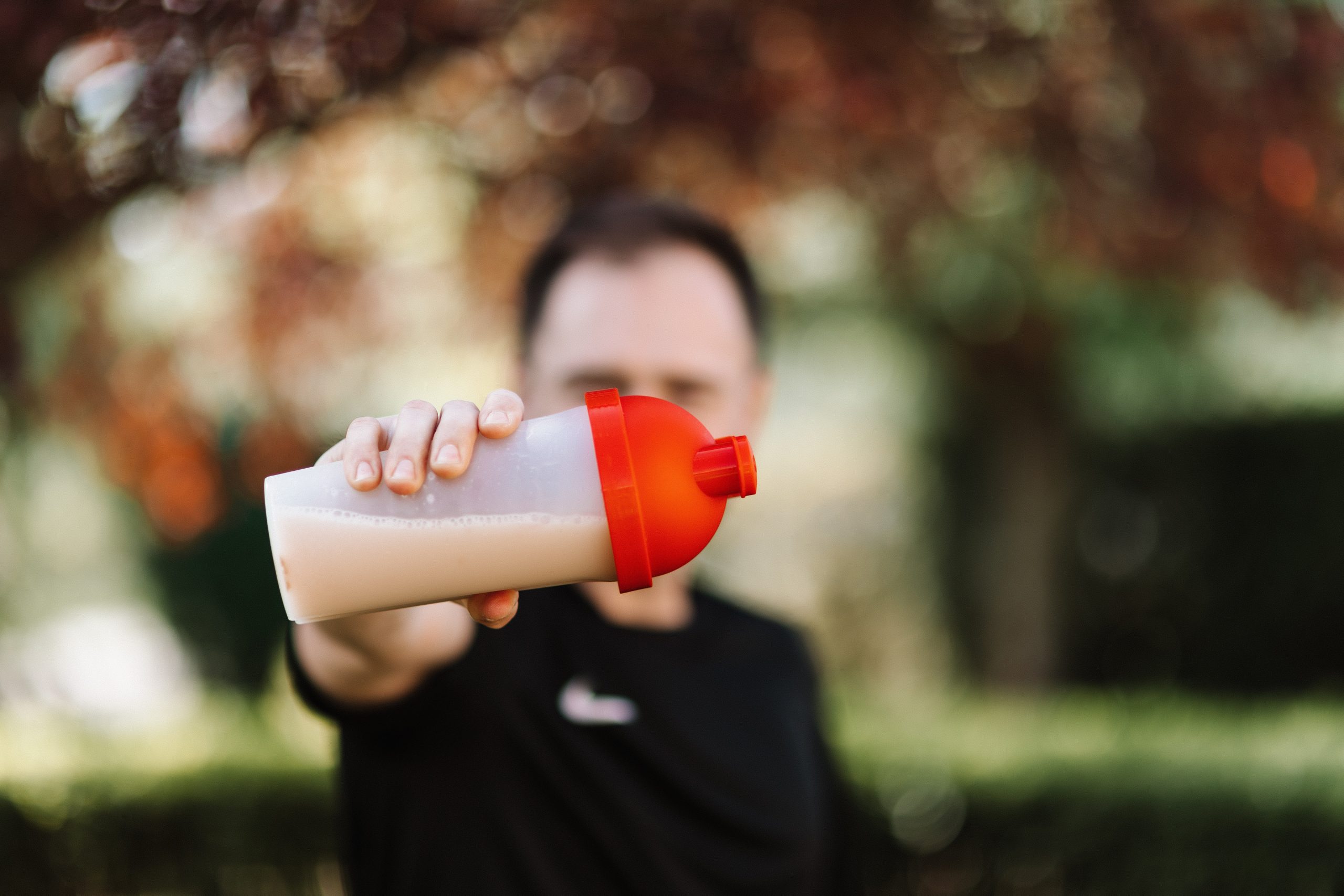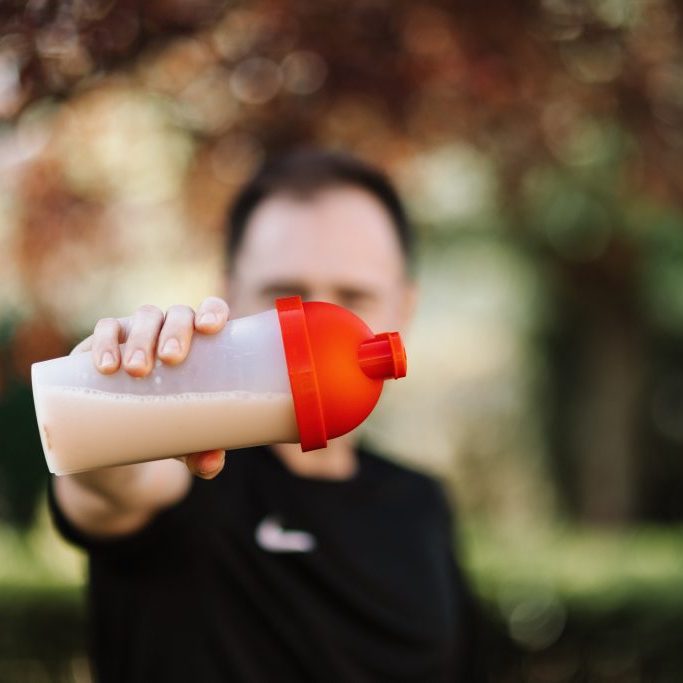The Importance Of Leucine Threshold For Building and Retaining Lean Body Mass
Leucine threshold. A topic many people, even in the fitness space are unaware of, but everybody should pay attention to.
Leucine as an amino acid, is often solely known as a supplement, but little understood in regards to its role for building muscle.
In this blog I would like to explain the mechanism of muscle protein synthesis to start with, what protein turnover actually is, what role leucine plays in all of that, why it becomes even more important as we age and how we can make sure we are consuming enough in order to cross that “leucine threshold”.
If you stick with me, you’ll come out of this with a better understanding of how muscle is developed and retained and some great practical tips for maximizing your potential for building and retaining lean body mass.

So let me start with the basics.
Muscle Protein Synthesis
Protein is the building block of muscles. Muscle protein synthesis is a naturally occurring process in which protein is produced to repair muscle damage caused by exercise. It is the opposing force to muscle protein breakdown (MPB) in which protein is lost as a result of exercise.
The ratio of MPS to MPB determines whether muscle tissues are built or “lost”. If MPS outpaces MPB, muscle growth is achieved. If MPB outpaces MPS, the opposite occurs.
MPS can be enhanced through sufficient protein intake. The amino acids that come from protein will then be shuttled to your muscles, replacing any protein “lost” to exercise. Learning how to stimulate MPS through exercise and diet can help you accelerate muscle growth, improve recovery and athletic performance, and increase overall endurance (1).
I won’t go into detail why we usually recommend about 0.8-1.2g of protein per day per pound of body mass, as this is a topic that has been discussed numerous times (for example check out Cody’s podcast HERE)
But a major misconception with protein is that what you eat goes right to the muscle tissue. When we ingest protein, it actually first goes to the stomach, then the small intestine, from here into the blood and to the liver where they are synthesized. Only about 55-60% of amino acids (the simpler protein form) make it to the liver and from here only about half of that make it to your muscle. (2)
Protein Turnover
This refers to the continual renewal or replacement of protein in the body. It is defined by the balance between protein synthesis and protein degradation. When an organism or a cell (for example muscle cells) is growing, the rate of protein synthesis exceeds that of protein degradation (anabolism), while the opposite is true during periods of catabolism. As mentioned above, there is a constant flux between the two. There is never a standstill.
What does that mean for us? In times where protein availability in the body is low and protein breakdown is high (let’s say you had a hard training session) there is no or little muscle protein synthesis/ build up. This is because the available amino acid pool is low so your organs like the liver and heart get preferential pull off of the available amino acids. Why? Because they are obviously more essential for your survival, which is always your body’s number 1 task.
But, protein synthesis is never simply on or off. During times where there is not much food in the system, the rates of protein turnover in various tissues changes.
Does this mean performing your workouts fasted, longer periods of intermittent fasting or only eating one high protein meal per day has a detrimental impact on your performance or for hypertrophy? No, there is a good amount of research that shows total protein over the course of the day is most important.
BUT, could your workouts, muscle growth and performance be optimized if you went into them with more amino acids in your blood? Likely. It’s logical to consider that organs get priority during fasting and the muscles (which account for 50% of protein needs in the body) will pull a lot more from that amino acid pool after being fed.
Eating a meal causes an uptick in protein synthesis and down regulation in protein breakdown. Fasting between meals and at night causes an uptick in protein breakdown and decrease in protein synthesis. But once again, the TOTAL protein eaten every day is what determines if you push the entire system in muscle gain or muscle loss territory. (3) So far so good, you likely already knew this, but I wanted to lay the groundwork.
But let me make my point more specifically…
Why Protein Content in Each Meal IS Important After All
While much of your body tissue (so weight loss or gain) is highly sensitive to total calories in terms of repair, muscle tissue is impacted on a greater scale by total protein.
This is controlled in large part by the enzyme called mTor (4). Mammalian target of rapamycin (mTOR) is an evolutionarily conserved serine/threonine kinase, and is known to play vital roles in protein synthesis. Here is a quick breakdown of what it does: mTor is essentially the master switch of protein synthesis at the initiation phase. Think of turning the key in your car to start the engine. You can have a full tank of gas, fresh oil, great tires and a big engine but none of that will run unless you have something to turn it all on. That is how you can think of mTor: the “on” switch for muscle building.
mTor is sensitive to a few other things:
– Strength training and exercise
– Insulin
– Total Calories
– Leucine
It should come as no surprise that you won’t build much muscle if you don’t exercise, eat very little total food and eat very little protein. Most people can wrap their heads around that. But, what is it specifically about leucine that is so important for building muscle?
What Does Leucine Actually Do?
Leucine is one of the nine essential amino acids (so the compounds protein is broken down to).
When you eat protein that contains leucine, leucine enters the bloodstream and goes straight to the muscle (5); this is how your muscles sense the ingestion of a meal and whether or not they can begin protein synthesis to create more tissue (build muscle).
The hypothesis is that to maximize this response about 2.5g of leucine is required, otherwise known as LEUCINE THRESHOLD.
In more detail, a meal containing 0.04 g of leucine per kilogram of bodyweight (g/kg BW) or about 0.18 g per pound, from a high-quality protein source will allow you to hit the leucine threshold. For most people this is somewhere between 2–4g leucine per meal. (6)
Let’s take an average cut of beef, which has a bit over 8% leucine of total protein. So in a 5oz steak with 40g protein, the leucine content for that meal is about 3.2g. It meets the leucine threshold but not to the whopping extent most people would assume.
This also sheds some light on why eating enough protein in a meal is important. For example, you cut that portion down to 3oz, you would only be getting about 1.92g leucine which does not quite meet the threshold for protein synthesis.
Increasing Protein/ Leucine Needs As We Age
Adding to that, when we are younger and developing, we are not nearly as sensitive to leucine as we are as adults (7). That is because we rely much more on insulin to stimulate growth of tissue when we are young. Physiologically speaking this is a much smarter and fool-proof method of achieving growth because a developing child doesn’t need to rely on protein as the sole stimulator of growing new tissue and putting on muscle, they simply need enough total calories. Since insulin is spiked by protein and carbohydrates alike, a growing child can develop and create new tissue from eating a wider variety of food sources.
As an adult, mTor is primarily sensitive to leucine and this sensitivity increases as we age and we rely even more on adequate protein and leucine intake to retain or build muscle (since we are also working against muscle sarcopenia, so muscle atrophy or degenerative loss of skeletal muscle mass, quality, and strength). That means as we age, protein consumption should actually INCREASE (8) and leucine threshold is estimated to be closer to e ∼3–4 g/meal, which would correspond to ∼20–30 g protein/meal.
Carbs To The Rescue!
Even if our adult bodies are more sensitive to leucine than insulin when it comes to triggering muscle protein synthesis, some research is showing that with a suboptimal dose of amino acids/ protein having enough carbs in your meal may be an effective strategy for “rescuing” the submaximal response of muscle protein synthesis, which is normally associated with the suboptimal dose of amino acids/ protein (9), whereas fats do not appear to have the same benefits. That means a low fat yoghurt with banana and oats as a post workout meal with only 10g protein is likely more beneficial for muscle protein synthesis than a handful of nuts with the same protein content.
A Few Notes On Leucine
– Body size: Leucine threshold is not as related to lean body mass as it is to blood volume. Since blood volume doesn’t change very much even with big weight disparities for the same height, the leucine threshold doesn’t change much either. There is no “simple” formula or measurement to find out your personal leucine threshold, but height (and therefore more blood) is likely more of an indicator than weight. Blood leucine needs to about triple to switch mTor – so for most 2.5g to 3g leucine threshold should be perfectly fine.
– Simply spiking leucine and “flipping the mTor switch” alone does NOT mean you are going to build muscle. There are plenty of products out there like BCAAs that contain a few amino acids with leucine as a primary ingredient. If all essential amino acids are not available, flipping the switch doesn’t do anything. You need enough total protein to actually give the muscles something to turn into new tissue. Remember that mTor flips the switch, but you still need gas in the tank to get somewhere.
– Increasing leucine in a meal beyond what is necessary doesn’t turn muscle building on even MORE. Additionally, supplementing leucine in a meal that already contains an adequate amount is simple wasted money and leucine.
– Protein quality does make a big difference for hitting that leucine threshold. Consider above that I noted beef was about 8% leucine (10). A food like peanut butter is not only low in protein for it’s total calories but to meet the leucine threshold you’d need about 10 tablespoons which also happens to be about 1,000 calories. So choose wisely! Generally speaking, the amino acid (and therefore leucine) profile of animal proteins is superior in terms of triggering MSPs to plant proteins. Supplementing with BCAAs can help you make sure you are getting all your essential amino acids if you don’t consume a lot of animal protein (Ready HERE why).
– Whey Protein Isolate does have a great amino acid profile (about 11% vs 8% in beef as mentioned above), BUT consider that you are also missing out on the additional micronutrients, such as omega 3 fatty acids, iron or vitamin B, if you rely to heavily on protein powder as a protein source.
– While total daily protein is the most important in terms of losing or gaining muscle, the meals that you start and end your day with are also quite important. If you have slept 8 hours, you’ve been fasting for at least that long. When you wake up, protein synthesis is at an extreme low and a high-protein meal rich in leucine helps stimulate mTor and reverse the catabolic process of fasting. Likewise, before bed, a complete and slow-digesting protein can provide amino acids to help reduce catabolism (or muscle breakdown) while you sleep. Optimizing both of those meals can help push muscle growth even further and ensure you are recovering optimally. A slow-digesting protein for example is Casein.
So overall:
- Your metabolism is affected by how much muscle you have. The more you have, the more amino acids your body needs to maintain your musculature.
- Of course it is also affected by active you are. The more you move around, the more protein your body needs.
- How old you are. The older you get, the more protein your body needs to maintain its muscle (11).
- Your hormones. Elevated levels of growth hormone and insulin-like growth factor 1 (IGF-1) stimulate muscle synthesis (12). If your body has high levels of these anabolic hormones, it will utilize protein better than someone that has low levels. On the other hand, elevated levels of cortisol reduces protein synthesis and accelerates the process whereby the body breaks down amino acids into glucose (gluconeogenesis). Read more on the pros and cons of cortisol in our blog HERE.
That means while 20-30g of protein per meal is sufficient for most people to hit the required leucine level, your own needs are individual and best tailored to you.
So to wrap it up, all this simply strengthens the argument for eating enough protein overall, but also for spreading out your protein intake evenly across the day.
To finish with I wanted to include a list of 10 foods high in Leucine (in no particular order). If you are searching for foods not on the list click HERE.
—————-Higher Leucine Sources——————
- Chicken Leg (closely followed by Chicken breast, ground Turkey, Turkey Breast, Duck and Goose)
per 100g: 2000mg, per 200 calories: 2174mg
- Beef Skirt Steak (closely followed by Chuck Steak and Rib Eye Steak, as well as Lamb, Beef Roast, ground beef etc)
per 100g: 2945mg, per 200 calories: 2198mg
- Pork Chops (closely followed by lean Ham)
per 100g: 2185mg, per 200 calories:1714mg
- Tuna
per 100g: 2431mg, per 200 calories: 2642mg
- Salmon (cooked)
per 100g: 2067mg, per 200 calories: 2271mg
—————-Lower Leucine Sources——————
- Firm Tofu (also edamame beans)
per 100g: 1392mg , per 200 calories: 1933mg
- Canned Navy Beans (also white beans, kidney beans, lentils)
per 100g: 639mg, per 200 calories:1131mg
- Milk (also yoghurt)
per 100g: 319mg, per 200 calories: 1876mg
- Low Fat Ricotta Cheese (also parmesan, swiss cheese, gouda)
per 100g: 1235mg, per 200 calories: 1790mg
- Eggs
per 100g: 1075mg, per 200 calories: 1387mg
Reference:
- Atherton, P. J., & Smith, K. (2012). Muscle protein synthesis in response to nutrition and exercise. The Journal of physiology, 590(5), 1049–1057. https://doi.org/10.1113/jphysiol.2011.225003
- https://med.libretexts.org/Courses/American_Public_University/APUS%3A_An_Introduction_to_Nutrition_(Byerley)/Text/05%3A_Proteins/5.04%3A_Protein_Digestion%2C_Absorption_and_Metabolism
- Schoenfeld BJ, Aragon AA, Krieger JW. The effect of protein timing on muscle strength and hypertrophy: a meta-analysis. J Int Soc Sports Nutr. 2013 Dec 3;10(1):53. doi: 10.1186/1550-2783-10-53. PMID: 24299050; PMCID: PMC3879660.
- Yoon M. S. (2017). mTOR as a Key Regulator in Maintaining Skeletal Muscle Mass. Frontiers in physiology, 8, 788. https://doi.org/10.3389/fphys.2017.00788
- Layman, D. K., Anthony, T. G., Rasmussen, B. B., Adams, S. H., Lynch, C. J., Brinkworth, G. D., & Davis, T. A. (2015). Defining meal requirements for protein to optimize metabolic roles of amino acids. The American journal of clinical nutrition, 101(6), 1330S–1338S. https://doi.org/10.3945/ajcn.114.084053
- Garlick P. J. (2005). The role of leucine in the regulation of protein metabolism. The Journal of nutrition, 135(6 Suppl), 1553S–6S. https://doi.org/10.1093/jn/135.6.1553S
- Tessier, A. J., & Chevalier, S. (2018). An Update on Protein, Leucine, Omega-3 Fatty Acids, and Vitamin D in the Prevention and Treatment of Sarcopenia and Functional Decline. Nutrients, 10(8), 1099. https://doi.org/10.3390/nu10081099
- Katsanos, C. S., Kobayashi, H., Sheffield-Moore, M., Aarsland, A., & Wolfe, R. R. (2006). A high proportion of leucine is required for optimal stimulation of the rate of muscle protein synthesis by essential amino acids in the elderly. American journal of physiology. Endocrinology and metabolism, 291(2), E381–E387. https://doi.org/10.1152/ajpendo.00488.2005
- Witard, O. C., Wardle, S. L., Macnaughton, L. S., Hodgson, A. B., & Tipton, K. D. (2016). Protein Considerations for Optimising Skeletal Muscle Mass in Healthy Young and Older Adults. Nutrients, 8(4), 181. https://doi.org/10.3390/nu8040181
- Phillips, S.M. The impact of protein quality on the promotion of resistance exercise-induced changes in muscle mass. Nutr Metab (Lond) 13, 64 (2016). https://doi.org/10.1186/s12986-016-0124-8
- Campbell, W. W., Trappe, T. A., Wolfe, R. R., & Evans, W. J. (2001). The recommended dietary allowance for protein may not be adequate for older people to maintain skeletal muscle. The journals of gerontology. Series A, Biological sciences and medical sciences, 56(6), M373–M380. https://doi.org/10.1093/gerona/56.6.m373
- Christiansen, J. J., Djurhuus, C. B., Gravholt, C. H., Iversen, P., Christiansen, J. S., Schmitz, O., Weeke, J., Jørgensen, J. O., & Møller, N. (2007). Effects of cortisol on carbohydrate, lipid, and protein metabolism: studies of acute cortisol withdrawal in adrenocortical failure. The Journal of clinical endocrinology and metabolism, 92(9), 3553–3559. https://doi.org/10.1210/jc.2007-0445
- Weinert D. J. (2009). Nutrition and muscle protein synthesis: a descriptive review. The Journal of the Canadian Chiropractic Association, 53(3), 186–193 https://www.ncbi.nlm.nih.gov/pmc/articles/PMC2732256/
- Arnal, M., Obled, C., Attaix, D., Patureau-Mirand, P., & Bonin, D. (1987). Dietary control of protein turnover. Diabete & metabolisme, 13(6), 630–642. https://pubmed.ncbi.nlm.nih.gov/3329127/
- Areta, J. L., Hawley, J. A., Ye, J. M., Chan, M. H., & Coffey, V. G. (2014). Increasing leucine concentration stimulates mechanistic target of rapamycin signaling and cell growth in C2C12 skeletal muscle cells. Nutrition research (New York, N.Y.), 34(11), 1000–1007. https://doi.org/10.1016/j.nutres.2014.09.011






















































































































































































































































































































































































































































































